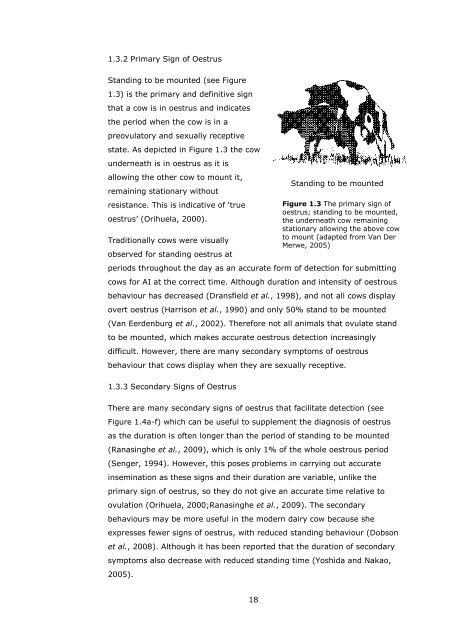novel approaches to expression and detection of oestrus in dairy cows
novel approaches to expression and detection of oestrus in dairy cows
novel approaches to expression and detection of oestrus in dairy cows
Create successful ePaper yourself
Turn your PDF publications into a flip-book with our unique Google optimized e-Paper software.
1.3.2 Primary Sign <strong>of</strong> Oestrus<br />
St<strong>and</strong><strong>in</strong>g <strong>to</strong> be mounted (see Figure<br />
1.3) is the primary <strong>and</strong> def<strong>in</strong>itive sign<br />
that a cow is <strong>in</strong> <strong>oestrus</strong> <strong>and</strong> <strong>in</strong>dicates<br />
the period when the cow is <strong>in</strong> a<br />
preovula<strong>to</strong>ry <strong>and</strong> sexually receptive<br />
state. As depicted <strong>in</strong> Figure 1.3 the cow<br />
underneath is <strong>in</strong> <strong>oestrus</strong> as it is<br />
allow<strong>in</strong>g the other cow <strong>to</strong> mount it,<br />
rema<strong>in</strong><strong>in</strong>g stationary without<br />
resistance. This is <strong>in</strong>dicative <strong>of</strong> ‘true<br />
<strong>oestrus</strong>’ (Orihuela, 2000).<br />
Traditionally <strong>cows</strong> were visually<br />
observed for st<strong>and</strong><strong>in</strong>g <strong>oestrus</strong> at<br />
St<strong>and</strong><strong>in</strong>g <strong>to</strong> be mounted<br />
Figure 1.3 The primary sign <strong>of</strong><br />
<strong>oestrus</strong>; st<strong>and</strong><strong>in</strong>g <strong>to</strong> be mounted,<br />
the underneath cow rema<strong>in</strong><strong>in</strong>g<br />
stationary allow<strong>in</strong>g the above cow<br />
<strong>to</strong> mount (adapted from Van Der<br />
Merwe, 2005)<br />
periods throughout the day as an accurate form <strong>of</strong> <strong>detection</strong> for submitt<strong>in</strong>g<br />
<strong>cows</strong> for AI at the correct time. Although duration <strong>and</strong> <strong>in</strong>tensity <strong>of</strong> oestrous<br />
behaviour has decreased (Dransfield et al., 1998), <strong>and</strong> not all <strong>cows</strong> display<br />
overt <strong>oestrus</strong> (Harrison et al., 1990) <strong>and</strong> only 50% st<strong>and</strong> <strong>to</strong> be mounted<br />
(Van Eerdenburg et al., 2002). Therefore not all animals that ovulate st<strong>and</strong><br />
<strong>to</strong> be mounted, which makes accurate oestrous <strong>detection</strong> <strong>in</strong>creas<strong>in</strong>gly<br />
difficult. However, there are many secondary symp<strong>to</strong>ms <strong>of</strong> oestrous<br />
behaviour that <strong>cows</strong> display when they are sexually receptive.<br />
1.3.3 Secondary Signs <strong>of</strong> Oestrus<br />
There are many secondary signs <strong>of</strong> <strong>oestrus</strong> that facilitate <strong>detection</strong> (see<br />
Figure 1.4a-f) which can be useful <strong>to</strong> supplement the diagnosis <strong>of</strong> <strong>oestrus</strong><br />
as the duration is <strong>of</strong>ten longer than the period <strong>of</strong> st<strong>and</strong><strong>in</strong>g <strong>to</strong> be mounted<br />
(Ranas<strong>in</strong>ghe et al., 2009), which is only 1% <strong>of</strong> the whole oestrous period<br />
(Senger, 1994). However, this poses problems <strong>in</strong> carry<strong>in</strong>g out accurate<br />
<strong>in</strong>sem<strong>in</strong>ation as these signs <strong>and</strong> their duration are variable, unlike the<br />
primary sign <strong>of</strong> <strong>oestrus</strong>, so they do not give an accurate time relative <strong>to</strong><br />
ovulation (Orihuela, 2000;Ranas<strong>in</strong>ghe et al., 2009). The secondary<br />
behaviours may be more useful <strong>in</strong> the modern <strong>dairy</strong> cow because she<br />
expresses fewer signs <strong>of</strong> <strong>oestrus</strong>, with reduced st<strong>and</strong><strong>in</strong>g behaviour (Dobson<br />
et al., 2008). Although it has been reported that the duration <strong>of</strong> secondary<br />
symp<strong>to</strong>ms also decrease with reduced st<strong>and</strong><strong>in</strong>g time (Yoshida <strong>and</strong> Nakao,<br />
2005).<br />
18
















